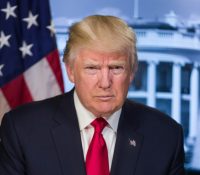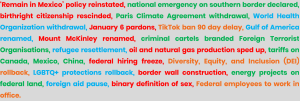Donald Trump installed as US President
Donald Trump’s second term as President number 47 of the United States began on Monday 20 January to great fanfare and a flurry of action. In this short note, we attempt to unwrap the three key layers of his presidency: the policy promises he has made to the American people, the people he has surrounded himself with and his approach to managing the process of government.

10th February 2025
-
Gavin Jones See profile
His policy promises
This time last year, the world faced challenges and uncertainty with continuing conflict in Ukraine and the Middle East. As well as the election in the UK and US, there were also elections in democracies such as Taiwan, India, Pakistan, Indonesia, and within the European Union.
Despite these headwinds, last year was generally another good year for most markets as the chart below illustrates.
Figure 1: Global investme
He has made several bold policy promises, from pledging to implement the largest deportation program in American history, reinstating a travel ban on several countries, to expediting permits for drilling and fracking as part of his ‘drill, baby, drill’ drive for prosperity. He also aims to roll back environmental regulations, withdraw the U.S. from the Paris Climate Accord, and potentially enact tariffs on goods from Mexico, Canada, and China. He has committed to dismantling diversity, equity and inclusion (DEI) policies alongside stating that only two sexes – male and female – will be recognised in US law. A radical focus on cutting government waste is also on the cards.
On his first day, he signed 26 executive orders, some of which are shown in the figure below.
Figure 1: Summary of key executive orders signed by Trump Day 1

Source: Co-pilot search for list of key executive orders on Day 1 of the 47th Presidency
It is a bold and controversial agenda. Promises are easy to make but harder to keep. The entire world heard his bold promise to end Russia’s war in Ukraine within 24 hours of taking office as President. That deadline has now passed, and, unsurprisingly, the conflict persists. It remains to be seen what he will have accomplished by the end of his four-year term.
His position as President is closely intertwined with the pursuit of personal prestige, power, and wealth, as demonstrated by the launch of his $TRUMP cryptocurrency meme coin—valued at US$6 billion—just prior to his inauguration.
His people
He has assembled a team blending ‘Making America Great Again’ (MAGA) loyalists and high-profile figures. Marco Rubio has been appointed Secretary of State, Fox News host Pete Hegseth nominated as Secretary of Defense, and Pam Bondi selected as Attorney General. Elon Musk has been brought in to lead efforts to reduce government waste, while the controversial Robert F. Kennedy Jr.—a vaccine sceptic and critic of processed foods—has been nominated as Secretary of Health and Human Services.
Trump demands loyalty, even a sense of fealty, in those he appoints. As his first term in office showed, anyone who steps over the line will incur his wrath and eternal damnation. This makes for a complex dynamic between skill, ability, loyalty and delivery. It seems likely that some may not survive the course. As Katty Kay (BBC) – alongside Anthony Scaramucci (formerly Trump’s Communications Director for ten days) – said in a recent episode of their brilliant podcast The Rest is Politics US, his administration is likely to resemble a middle-school punch-up!
For readers (or watchers) of Hillary Mantel’s Wolf Hall, some glaring similarities to the court of Henry VIII can be seen, where courtiers and advisors like Thomas More and Cardinal Wolsey gained and wielded significant influence, but ultimately failed to prove their loyalty to the King (having been schemed against by other members of the court) literally paying with their heads! The eclectic and diverse mix of people surrounding Trump and his attacks against those who fail to deliver or remain loyal, like Henry VIII, can lead to sudden and dramatic policy and personnel changes. Watch this space.
His approach
Trump as 45th President provided some glimpses of how he goes about the business of governing. His book The Art of the Deal (actually ghostwritten by Tony Schwartz) also provides some clues to his approach which include thinking big (making Canada the 51st state, annexing Greenland and taking back the Panama Canal for example), maximizing his options to keep opponents guessing, starting out with maximal positions (touted 60% tariffs on Chinese goods) and fighting back by doubling down, as seen over the past year during his court cases.
Whatever your views on Trump, his previous threats to withdraw from NATO if European nations did not start paying their way were valid and effective. Don’t expect this, or the general sense of chaos and coercion he instils to change. It is in his DNA. The raft of executive orders already signed and his declaration that the situation at the Mexican border is a national emergency, thus allowing the military to be brought in, points to a greater sense of direction and action than in his first term.
His impact on markets
So, how does all this impact on markets? When he was first re-elected, the US equity market rallied, perhaps as its view on future corporate earnings was favourable. On the other hand, the US bond market has suffered rising yields (falling prices) on the prospect of higher inflation on account of the strong economy and the prospect of Trump’s tariffs.
Going forward, no one knows what the impact will be of Trump’s second term in office. Markets will reflect new information as it is released, which is by definition a random event. We are yet to see the impact of the burgeoning global trade war in response to US tariffs and possible events such as a military clash with China over Taiwan, a deal with Russia and what that may mean for Ukraine and a highly confrontational dialogue with Iran. As investors, all we can do is remain highly diversified across equity markets, sectors and companies, and balance our equity risk by holding an adequate amount of higher quality bonds to see our way through any prolonged downturn in equity markets, if they should occur. We are, as ever, in uncertain times.

